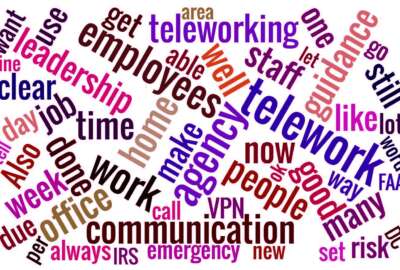
Be more like Susan — make telework a way of life
With a majority of federal employees teleworking, here are some best practices and lessons learned from experienced teleworkers for how you can be successful in...
For Susan, nothing much changed on March 15 when the Office of Management and Budget gave the order for federal employees to maximize telework.
Susan, who asked that her last name and agency be withheld because she didn’t get permission to talk to the press, has been a full-time teleworker for almost two decades.
On March 16 as most employees headed into work one more time to collect paperwork or laptops or whatever they needed to successfully telework, Susan fired up her computer in her Virginia home office, walked downstairs to make coffee and let the dogs out. It was just a regular day.
“I have my own office and whole set up that makes it much easier to be successful,” Susan said in an interview. “I can close my door so the kids or the cats and dogs don’t interrupt calls. They know if the door is closed, do not to come in.”
Susan is not like most federal employees. She rarely goes in to the office. She only “talks” to her boss, who teleworks himself from the West Coast, and her co-workers mostly by video teleconferencing, email or instant messaging applications.
But now the coronavirus has turned tens of thousands of federal workers into Susans. And many are not happy to be working remotely full-time.
A Federal News Network online survey of 1,047 federal employees found 77% of all respondents say they are teleworking today because of the coronavirus pandemic.
Read more: Workforce News
Of those, 47% of the respondents say they did not telework regularly before the emergency, meaning there are a lot of people who aren’t used to teleworking and may not be happy about it in the least.
“I understand why it is necessary, but I’d rather be in the office,” wrote one respondent.
Another said, “Was part time teleworking – now full time.”
Alex Alonso, the chief knowledge officer at the Society for Human Resource Management (SHRM) and an industrial organization psychologist who studies telework, said roughly 40% of all workers—public and private sector — have teleworked at some point over the last 50 years.
But the coronavirus has become a forced telework situation and that is something employees need to wrap their heads around in a different way.
“What people loved about telework was the flexibility it brought. That is [a] big issue when we give people guidance, they think they will have to give up that flexibility,” Alonso said. “You can still do work and do it differently. It can be at different times when you are at home. For a lot of people that is something to wrap their heads around. You are trading one set of flexibilities for another.”
Full-time teleworkers will say there are some basic dos and don’ts that everyone should follow.
Susan follows a routine. She starts by logging on and getting a solid two hours of work in before taking her first short break.
“It really helps me keep my focus to take regular breaks,” she said. “When you work in a regular office there are tons of distractions that let you take a mental break. But when you are in home office, you can get siloed so it’s important to take breaks.”
Alonso agreed. Having a routine is important, especially one that allows you to stay mentally healthy and refreshed.
“When you are working from home, it’s easy to end up with rote routines. But everyone needs time to think about things. That can happen on your car ride or train ride home, but you don’t have that time when your workplace is at home so you need to build in those moments,” he said. “You should structure time in your day when you can engage in pure thinking about a specific problem or issue. When you set up guideposts, it gives you a limited time frame to focus on something not part of your normal work day.”
Susan said a recent change for her is to create a group of three or four colleagues that she keeps in touch with at least daily, if not several times a day.
“Working from home can be solitary,” she said. “Many of us have work groups in an email loop where we can fire questions back and forth to bounce ideas. It really helps to have a small group you can collaborate with and share and ask questions with because it keeps you connected and tethers you to the office. I didn’t have that at first and I would go into the office and not know anyone.”
Alonso said the need to create social interactions that are more than just an email falls more on supervisor or manager’s shoulders than anyone else.
“There needs to be a replacement for the in-person social interaction we are all used to, and not just work based interaction. We’ve been seeing lot of employers in professional services firms holding virtual happy hours where it’s not just a social hour once a day where you interact with people on your team but a non-work setting to talk about other things,” he said. “We tell managers to focus on being extra. I know it sounds corny, but we are asking people to be extra in how they approach and interact with people. Technology will fail and have hang ups. We all will need patience.”
He said SHRM takes the first 15 minutes of every meeting to provide general check-in to see how everyone is doing, and then they do a specific check-in at the end of the week about how everyone is feeling.
Read more: Coronavirus resources for feds
One of the biggest problems teleworkers face, whether new ones or veterans of remote working, is the inability to turn off work: Checking email one more time, or going back to a report at 11 p.m. once everyone else is in bed.
Susan said she makes sure her day ends, even it means flexing her time to work four hours in the morning and then four hours in the evening if she had to deal with kids when they were little or other appointments.
“It’s just too tempting to check on one more thing, which means your day never ends,” she said. “If you leave [your] computer and system up and running, it’s too tempting to check on one more email or check on one more thing. That’s not good for your family life or mental health. You have to turn everything off. Our office protocol is to set an out of office reminder so co-workers and managers know when you are there and when you aren’t.”
Finally, Alonso said for those employees who aren’t excited about working from home, a good way to get them engaged and excited about work is to offer them a distraction of sorts.
“A good way to get people motivated is by having them do some sort of cross functional work or rotation. It’s helpful for me to switch up what I’m doing where I may do something that is geared more toward introspection and coming up with a response,” he said. “If I’m do something new and novel, then I’m not thinking about working from home. That can be powerful when I’m focused on my own learning and professional development.”
The one silver lining Susan, Alonso and many others in the survey hoped to come from this coronavirus pandemic is a realization that telework is more than just a nice to have during snow storms. It’s also a way of working that benefits agencies and employees alike.
“This may be a good litmus test showing managers that employees can telework. I hope the ability to telework will continue after the crisis is over; one or two days a week would be great. Hopefully, the push-back concerning telework from supervisors as well as more established employees will decrease,” wrote one survey respondent.
Copyright © 2025 Federal News Network. All rights reserved. This website is not intended for users located within the European Economic Area.
Jason Miller is executive editor of Federal News Network and directs news coverage on the people, policy and programs of the federal government.
Follow @jmillerWFED





